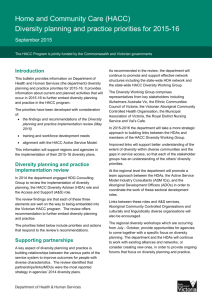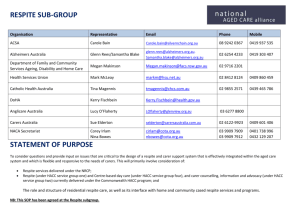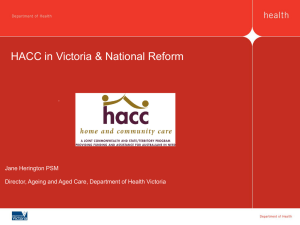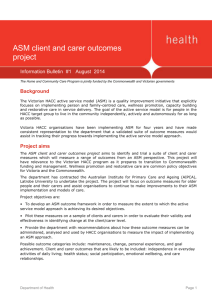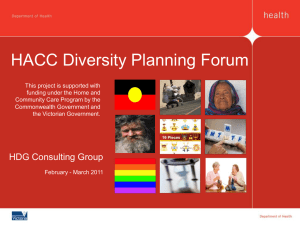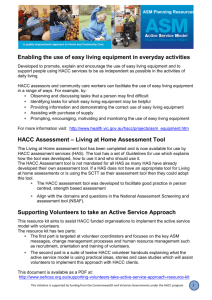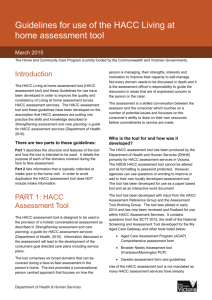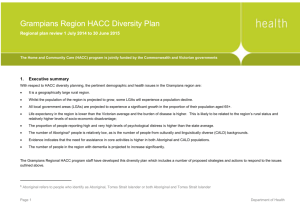LGPRF Practice Note 3: HACC Participation Measures (DOCX 43.0
advertisement
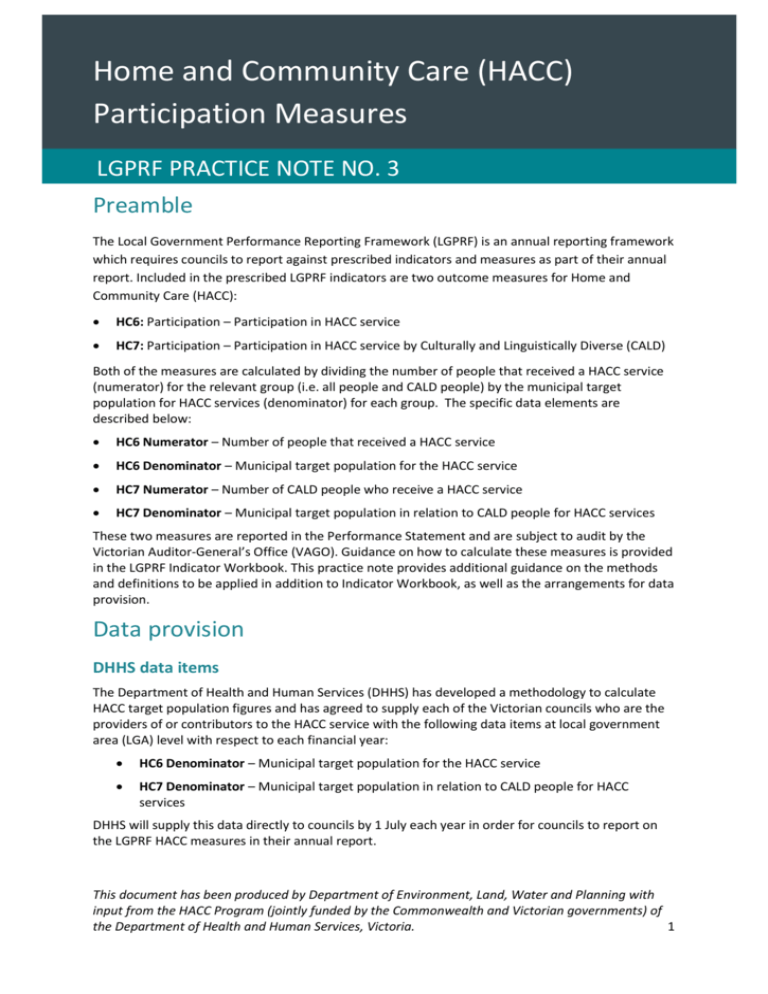
Home and Community Care (HACC) Participation Measures LGPRF PRACTICE NOTE NO. 3 Preamble The Local Government Performance Reporting Framework (LGPRF) is an annual reporting framework which requires councils to report against prescribed indicators and measures as part of their annual report. Included in the prescribed LGPRF indicators are two outcome measures for Home and Community Care (HACC): HC6: Participation – Participation in HACC service HC7: Participation – Participation in HACC service by Culturally and Linguistically Diverse (CALD) Both of the measures are calculated by dividing the number of people that received a HACC service (numerator) for the relevant group (i.e. all people and CALD people) by the municipal target population for HACC services (denominator) for each group. The specific data elements are described below: HC6 Numerator – Number of people that received a HACC service HC6 Denominator – Municipal target population for the HACC service HC7 Numerator – Number of CALD people who receive a HACC service HC7 Denominator – Municipal target population in relation to CALD people for HACC services These two measures are reported in the Performance Statement and are subject to audit by the Victorian Auditor-General’s Office (VAGO). Guidance on how to calculate these measures is provided in the LGPRF Indicator Workbook. This practice note provides additional guidance on the methods and definitions to be applied in addition to Indicator Workbook, as well as the arrangements for data provision. Data provision DHHS data items The Department of Health and Human Services (DHHS) has developed a methodology to calculate HACC target population figures and has agreed to supply each of the Victorian councils who are the providers of or contributors to the HACC service with the following data items at local government area (LGA) level with respect to each financial year: HC6 Denominator – Municipal target population for the HACC service HC7 Denominator – Municipal target population in relation to CALD people for HACC services DHHS will supply this data directly to councils by 1 July each year in order for councils to report on the LGPRF HACC measures in their annual report. This document has been produced by Department of Environment, Land, Water and Planning with input from the HACC Program (jointly funded by the Commonwealth and Victorian governments) of the Department of Health and Human Services, Victoria. 1 LGPRF PRACTICE NOTE NO. 3 Council data items Due to the timing of council data supply to DHHS and the need for audit of the council performance statements by VAGO, councils will need to obtain data for the following items from their HACC information systems: HC6 Numerator – Number of people that received a HACC service HC7 Numerator – Number of CALD people who receive a HACC service For the purposes of these data items, ‘HACC service’ relates only to the provision of domestic assistance, personal care and respite care DHHS will provide councils with the verified data for these data items by 31 August each year for the purposes of final validation of the reported measures. If there is a material difference between a council’s reported data and the DHHS data, the council will need to discuss with their auditor any changes required to their final reported data. Data definitions and methods It is important that councils use consistent methods and definitions when calculating these measures to ensure comparability of data between councils. Client counting process Current practice requires HACC service providers to create quarterly reports about the characteristics of all clients who receive a HACC-funded service and about the type and quantity of services provided and report this data electronically to DHHS. This data then forms part of the National HACC Minimum Data Set (MDS). The HACC Program National MDS User Guide includes all the data elements that HACC providers are required to report consistently. The national HACC Data Dictionary contains definitions for each of these data elements. It also defines certain data elements and concepts which are not reported via the MDS, but which must be built into an agency’s datacollecting system in order to support the elements that are actually reported. For HC6 numerator: To determine the number of people who received a HACC service (domestic assistance, personal care, and/or respite care) during the financial year, councils should aggregate their client records across the whole of the financial year without double counting client records. Thus a client who received both domestic assistance and personal care should be counted only once. A client who received a service in two quarters should be counted only once. For HC7 numerator: Use the same method as for HC6, but include only records pertaining to CALD clients, as defined below. This document has been produced by Department of Environment, Land, Water and Planning with input from the HACC Program (jointly funded by the Commonwealth and Victorian governments), of the Department of Health and Human Services, Victoria. 2 LGPRF PRACTICE NOTE NO. 3 Culturally and Linguistically Diverse (CALD) people CALD is determined on the basis of the person being born in a non-English speaking country; that is, people who were born in countries other than those classified by the Australian Bureau of Statistics (ABS) as main English speaking countries. The set of main English speaking countries other than Australia used by the ABS comprises: Canada Ireland New Zealand South Africa United Kingdom (England, Scotland, Wales, Northern Ireland) United States of America. The list of main English speaking countries can be checked by consulting the Glossary section of the ABS Cat 3417.0 - Understanding Migrant Outcomes - Enhancing the Value of Census Data, Australia, 2011. Municipal Target Population for HACC services These figures will be supplied to councils from data prepared by DHHS. The HACC target group encompasses ‘older and frail people with moderate, severe or profound disabilities, younger people with moderate, severe or profound disabilities, and their unpaid carers’. For this purpose, carers are not counted separately from clients. The size and location of the HACC target population in Victoria is estimated from responses to Census questions on Need for Assistance with self-care, mobility or communication, counted at the local government area (LGA) level, with other adjustments. Further Information Please refer all enquiries in relation to this practice note to: Amelia Chapman Manager Sector Performance Local Government Victoria amelia.chapman@delwp.vic.gov.au 03 9948 8533 This document has been produced by Department of Environment, Land, Water and Planning with input from the HACC Program (jointly funded by the Commonwealth and Victorian governments), of the Department of Health and Human Services, Victoria. 3

